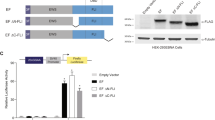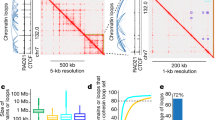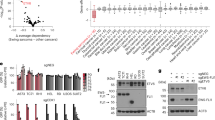Abstract
In all, 85% of Ewing's sarcoma family tumors (ESFT), a neoplasm of unknown histogenesis, express EWS-FLI1 transcription factor gene fusions. To characterize direct target genes avoiding artificial model systems, we cloned genomic DNA from ESFT chromatin precipitating with EWS-FLI1. We now present a comprehensive list of 99 putative transcription factor targets identified, for the first time, by a hypothesis-free approach based on physical interaction. Gene-derived chromatin fragments co-precipitating with EWS-FLI1 were nonrandomly distributed over the human genome and localized predominantly to the upstream region and the first two introns of the genes. At least 20% of putative direct EWS-FLI1 targets were neural genes. One-third of genes recovered showed a significant ESFT-specific expression pattern and were found to be altered upon RNAi-mediated knockdown of EWS-FLI1. Among them, MK-STYX, encoding a MAP kinase phosphatase-like protein, was consistently expressed in ESFT. EWS-FLI1 was found to drive MK-STYX expression by binding to a single ETS binding motif within the first gene intron. MK-STYX serves as precedence for successful recovery of direct EWS-FLI1 targets from the authentic ESFT cellular context, the most relevant system to study oncogenic mechanisms for the discovery of new therapeutic targets in this disease.
This is a preview of subscription content, access via your institution
Access options
Subscribe to this journal
Receive 50 print issues and online access
$259.00 per year
only $5.18 per issue
Buy this article
- Purchase on Springer Link
- Instant access to full article PDF
Prices may be subject to local taxes which are calculated during checkout






Similar content being viewed by others
References
Arvand A, Bastians H, Welford SM, Thompson AD, Ruderman JV and Denny CT . (1998). Oncogene, 17, 2039–2045.
Arvand A, Welford SM, Teitell MA and Denny CT . (2001). Cancer Res., 61, 5311–5317.
Bailly RA, Bosselut R, Zucman J, Cormier F, Delattre O, Roussel M, Thomas G and Ghysdael J . (1994). Mol. Cell. Biol., 14, 3230–3241.
Braun BS, Frieden R, Lessnick SL, May WA and Denny CT . (1995). Mol. Cell. Biol., 15, 4623–4630.
Brummelkamp TR, Bernards R and Agami R . (2002). Cancer Cell, 2, 243–247.
Chansky HA, Hu M, Hickstein DD and Yang L . (2001). Cancer Res., 61, 3586–3590.
Dauphinot L, De Oliveira C, Melot T, Sevenet N, Thomas V, Weissman BE and Delattre O . (2001). Oncogene, 20, 3258–3265.
Delattre O, Zucman J, Melot T, Garau XS, Zucker JM, Lenoir GM, Ambros PF, Sheer D, Turc-Carel C, Triche TJ, Aurias A and Thomas G . (1994). N. Engl. J. Med., 331, 294–299.
Delva L, Gallais I, Guillouf C, Denis N, Orvain C and Moreau-Gachelin F . (2004). Oncogene, 23, 4389–4399.
Deneen B and Denny CT . (2001). Oncogene, 20, 6731–6741.
Deneen B, Hamidi H and Denny CT . (2003a). Cancer Res., 63, 4268–4274.
Deneen B, Welford SM, Ho T, Hernandez F, Kurland I and Denny CT . (2003b). Mol. Cell. Biol., 23, 3897–3908.
Dohjima T, Lee NS, Li H, Ohno T and Rossi JJ . (2003). Mol. Ther., 7, 811–816.
Eliazer S, Spencer J, Ye D, Olson E and Ilaria Jr RL . (2003). Mol. Cell. Biol., 23, 482–492.
Fuchs B, Inwards CY and Janknecht R . (2003). FEBS Lett., 553, 104–108.
Fuchs B, Inwards CY and Janknecht R . (2004). Clin. Cancer Res., 10, 1344–1353.
Fukuma M, Okita H, Hata J and Umezawa A . (2003). Oncogene, 22, 1–9.
Hahm KB, Cho K, Lee C, Im YH, Chang J, Choi SG, Sorensen PH, Thiele CJ and Kim SJ . (1999). Nat. Genet., 23, 22–227.
Hallier M, Lerga A, Barnache S, Tavitian A and Moreau-Gachelin F . (1998). J. Biol. Chem., 273, 4838–4842.
Hattinger CM, Potschger U, Tarkkanen M, Squire J, Zielenska M, Kiuru-Kuhlefelt S, Kager L, Thorner P, Knuutila S, Niggli FK, Ambros PF, Gadner H and Betts DR . (2002). Br. J. Cancer, 86, 1763–1769.
Hattinger CM, Rumpler S, Strehl S, Ambros IM, Zoubek A, Potschger U, Gadner H and Ambros PF . (1999). Genes Chromosomes Cancer, 24, 243–254.
Im YH, Kim HT, Lee C, Poulin D, Welford S, Sorensen PH, Denny CT and Kim SJ . (2000). Cancer Res., 60, 1536–1540.
Kovar H, Jug G, Hattinger C, Spahn L, Aryee DN, Ambros PF, Zoubek A and Gadner H . (2001). Cancer Res., 61, 5992–5997.
Lessnick SL, Braun BS, Denny CT and May WA . (1995). Oncogene, 10, 423–431.
Lessnick SL, Dacwag CS and Golub TR . (2002). Cancer Cell, 1, 393–401.
Matsui Y, Chansky HA, Barahmand-Pour F, Zielinska-Kwiatkowska A, Tsumaki N, Myoui A, Yoshikawa H, Yang L and Eyre DR . (2003). J. Biol. Chem., 278, 11369–11375.
May WA, Arvand A, Thompson AD, Braun BS, Wright M and Denny CT . (1997). Nat. Genet., 17, 495–497.
May WA, Gishizky ML, Lessnick SL, Lunsford LB, Lewis BC, Delattre O, Zucman J, Thomas G and Denny CT . (1993a). Proc. Natl. Acad. Sci. USA, 90, 5752–5756.
May WA, Lessnick SL, Braun BS, Klemsz M, Lewis BC, Lunsford LB, Hromas R and Denny CT . (1993b). Mol. Cell. Biol., 13, 7393–7398.
Nakatani F, Tanaka K, Sakimura R, Matsumoto Y, Matsunobu T, Li X, Hanada M, Okada T and Iwamoto Y . (2003). J. Biol. Chem., 278, 15105–15115.
Nishimori H, Sasaki Y, Yoshida K, Irifune H, Zembutsu H, Tanaka T, Aoyama T, Hosaka T, Kawaguchi S, Wada T, Hata J, Toguchida J, Nakamura Y and Tokino T . (2002). Oncogene, 21, 8302–8309.
Ohkura N, Yaguchi H, Tsukada T and Yamaguchi K . (2002). J. Biol. Chem., 277, 535–543.
Ohno T, Rao VN and Reddy ES . (1993). Cancer Res., 53, 5859–5863.
Rorie CJ, Thomas VD, Chen P, Pierce HH, O'Bryan JP and Weissman BE . (2004). Cancer Res., 64, 1266–1277.
Schaefer KL, Brachwitz K, Wai DH, Braun Y, Diallo R, Korsching E, Eisenacher M, Voss R, Van Valen F, Baer C, Selle B, Spahn L, Liao SK, Lee KA, Hogendoorn PC, Reifenberger G, Gabbert HE and Poremba C . (2004). Cancer Res., 64, 3395–3405.
Spahn L, Petermann R, Siligan C, Schmid JA, Aryee DN and Kovar H . (2002). Cancer Res., 62, 4583–4587.
Staal A, van Wijnen AJ, Birkenhager JC, Pols HA, Prahl J, DeLuca H, Gaub MP, Lian JB, Stein GS, van Leeuwen JP and Stein JL . (1996). Mol. Endocrinol., 10, 1444–1456.
Takahashi A, Higashino F, Aoyagi M, Yoshida K, Itoh M, Kyo S, Ohno T, Taira T, Ariga H, Nakajima K, Hatta M, Kobayashi M, Sano H, Kohgo T and Shindoh M . (2003). Cancer Res., 63, 8338–8344.
Teitell MA, Thompson AD, Sorensen PH, Shimada H, Triche TJ and Denny CT . (1999). Lab. Invest., 79, 1535–1543.
Thompson AD, Braun BS, Arvand A, Stewart SD, May WA, Chen E, Korenberg J and Denny C . (1996). Oncogene, 13, 2649–2658.
Torchia EC, Jaishankar S and Baker SJ . (2003). Cancer Res., 63, 3464–3468.
Watanabe G, Nishimori H, Irifune H, Sasaki Y, Ishida S, Zembutsu H, Tanaka T, Kawaguchi S, Wada T, Hata J, Kusakabe M, Yoshida K, Nakamura Y and Tokino T . (2003). Genes Chromosomes Cancer, 36, 224–232.
Watson DK, Robinson L, Hodge DR, Kola I, Papas TS and Seth A . (1997). Oncogene, 14, 213–221.
Weinmann AS and Farnham PJ . (2002). Methods, 26, 37–47.
Wishart MJ and Dixon JE . (1998). Trends Biochem. Sci., 23, 301–306.
Wishart MJ and Dixon JE . (2002). Proc. Natl. Acad. Sci. USA, 99, 2112–2117.
Zwerner JP, Guimbellot J and May WA . (2003). Exp. Cell Res., 290, 414–419.
Acknowledgements
We thank Franz Watzinger and Lenka Baskova for help with real-time PCR. This study was supported in part by Grants 14299GEN and 16067-B04 from the Austrian Science Fund, by Grant GZ 200.071/3-VI/2a/2002 ‘GEN-AU Child’ from the Austrian Federal Ministry of Education, Science, and Culture, and Grant Po 529/5-1 from the Deutsche Forschungsgemeinschaft (DFG).
Author information
Authors and Affiliations
Corresponding author
Rights and permissions
About this article
Cite this article
Siligan, C., Ban, J., Bachmaier, R. et al. EWS-FLI1 target genes recovered from Ewing's sarcoma chromatin. Oncogene 24, 2512–2524 (2005). https://doi.org/10.1038/sj.onc.1208455
Received:
Revised:
Accepted:
Published:
Issue Date:
DOI: https://doi.org/10.1038/sj.onc.1208455
Keywords
This article is cited by
-
The pseudoenzyme ADPRHL1 affects cardiac function by regulating the ROCK pathway
Stem Cell Research & Therapy (2023)
-
STYXL1 promotes proliferation and epithelial mesenchymal transition of gastric cancer cells via activating the PI3K/AKT pathway
Molecular & Cellular Toxicology (2023)
-
A polypeptide from the junction region sequence of EWS-FLI1 inhibits Ewing’s sarcoma cells, interacts with the EWS-FLI1 and partner proteins
Scientific Reports (2017)
-
The regulatory roles of phosphatases in cancer
Oncogene (2014)
-
Suppression of FOXO1 is responsible for a growth regulatory repressive transcriptional sub-signature of EWS-FLI1 in Ewing sarcoma
Oncogene (2014)



